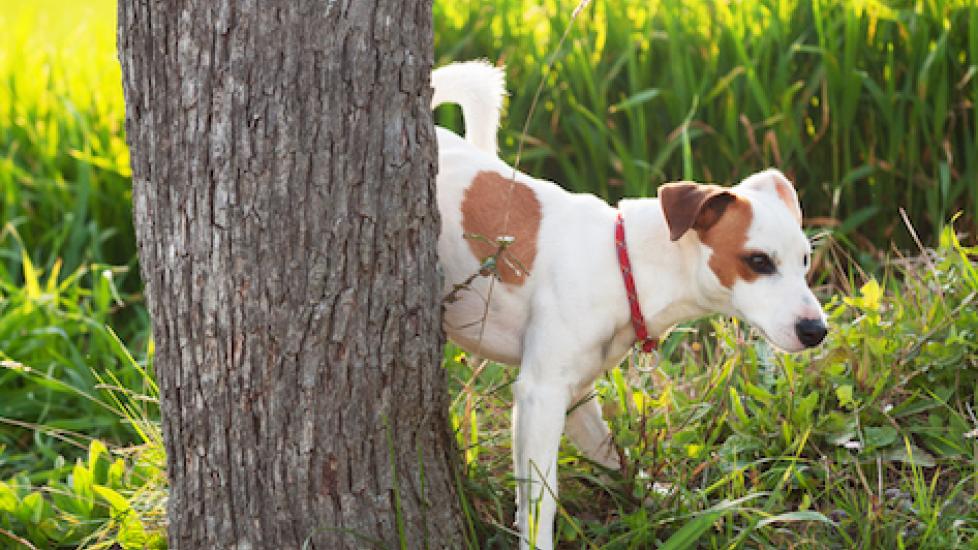What Your Pet’s Urine Says About His Health
By Hanie Elfenbein, DVM
Most urban and suburban pet parents are very familiar with the details of their pets’ feces because they have to scoop it daily on walks. A dog’s urine, however, is often harder to keep track of because it quickly disappears into the grass or dirt. But sometimes you may notice changes in the color or odor of your dog’s urine. For cats, of course, monitoring the cat litter box is key to noticing any changes.
The most important thing to remember is that in order to notice a change, you should first make yourself familiar with the characteristics of your pet’s urine while he or she is healthy. A change from whatever is normal for your pet may indicate a change in his or her health.
If you do notice a change, try to catch a sample from your dog in a clean disposable container and bring it to your veterinarian’s office. Even if you can’t schedule an appointment for a few days, you can start to diagnose the problem and hopefully resolve it. Cats must usually be brought into the clinic where a sample can be collected, although there are some non-absorbent litters that are designed for collecting urine samples at home. Ideally, urine should be delivered fresh to your veterinary clinic within one hour or refrigerated.
Characteristics of Your Pet’s Urine
Color
Clear: This either means that your pet is well hydrated or it’s a sign that he or she is unable to concentrate urine. There are many reasons that pets cannot concentrate their urine. If you are concerned that your pet’s urine may not be concentrated, the best sample to bring to your veterinarian is their first-morning urine. It tends to be the most concentrated sample of the day.
Yellow: This may indicate concentrated urine, in which case your dog or cat should be encouraged to drink more water. Cat or dog water fountains may increase water intake. Some pets prefer to drink out of cups rather than bowls and others prefer glass to metal.
*Note: Clear urine is not necessarily dilute nor is yellow urine necessarily concentrated. But it is a good first guideline.
Red, Brown, or Orange: This may indicate blood in the urine. Some medications may also give urine an orange or red tint. In dogs, blood in urine is most likely due to an infection or bladder stones. Cats may also develop bloody urine in response to stress. Animals prone to developing bloody urine may have an underlying disease that can be addressed with something as simple as a change in diet. This is definitely one urine change worth talking to your veterinarian about.
Odor
Any change in odor should be a reason to have your pet’s urine analyzed by a veterinarian. Foul smelling urine is often an indicator of infection. Concentrated urine will have a stronger smell.
Clarity
Cloudy urine can indicate an infection, bladder crystals, or stones. It could also indicate protein in the urine.
Quantity
If your pet starts urinating a much larger quantity (or the same quantity more frequently), that may indicate the kidneys are not doing their job to concentrate urine. This could be due to kidney disease or a hormonal influence on the kidneys. Either way, your veterinarian can help you manage or resolve the problem.
Frequency
Changes in frequency, stream, posturing without urinating, increased licking after urinating, or staining around the vulva or prepuce can all indicate a problem. See your veterinarian as soon as possible. For cats, visiting the litter box more frequently could be the most clear sign that something is wrong.
No Urine
If your pet does not urinate for 24 hours, it’s a medical emergency. There may be a blockage preventing urine from flowing into or out of the bladder. This is more common in cats than dogs, especially male cats. If you think your cat may be unable to urinate, rush to your veterinarian or the nearest emergency clinic.
Multi-Cat Households
If you have more than one cat using the same litter box, it can be hard to determine which one is having an issue. If one cat shows other signs, such as more time at the water bowl or less interest in cat food, that can help narrow it down.
There are some litters that claim to change color in response to changes in your cat’s urine. While these are great in theory, they are not always reliable.
Monitoring Your Pet’s Urine
Urine is a very valuable indicator of health in pets. It is part of the set of information that your veterinarian will want to analyze if your pet is sick. Performing a urine analysis at the same time as a blood analysis yields the most information because they are complementary—changes in one can often explain changes in the other. But these checks on internal body health aren’t just useful if your pet is sick. Knowing what is normal for your pet by analyzing urine and blood while they are healthy can make those sick tests even more valuable.
Monitoring your pet’s urine can offer valuable insight into his or her health. Taking note of changes and reporting them to your veterinarian will help your pet stay healthy.
